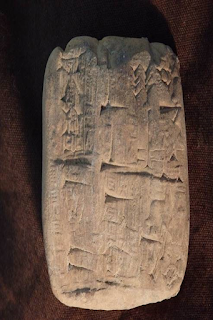Hobby Lobby Forfeiture: $3 Million is Not a Fine. So What Is It?
The case of United States v. Approximately Four Hundred Fifty (450) Ancient Cuneiform Tablets and Approximately Three Thousand (3,000) Ancient Clay Bullae–the Hobby Lobby cultural artifacts case—involves two parts:
(1) the court forfeiture of 3,450 cuneiform tablets and clay bullae illegally imported into the United States, and specifically named in the caption of the civil case, and
(2) the administrative forfeiture of $3 million in proceeds along with 144 unlawfully imported cylinder seals, which is outlined in the companion settlement agreement filed with the federal district court in Brooklyn, New York.
So how did prosecutors arrive at this $3 million figure?
As stated in CHL’s July 6 blog post, the amount is not a fine or penalty levied against Hobby Lobby, contrary to what has been widely reported in the media. A fine is a form of punishment. Instead, the $3 million forfeitable proceeds (to use the technical term) represents a kind of restitution, covering the financial worth of acquired artifacts that no longer were available to hand over to U.S. authorities.
Cultural property forfeitures typically involve the seizure and forfeiture of hot cultural objects, not cold cash in lieu of the objects themselves. That is because cultural property seizures usually are civil in rem actions, meaning that the lawsuits involve the U.S. v. The Actual Stuff to be Forfeited rather than criminal in personam actions that involve the U.S. v. John Doe, where the fruits and contraband of John Doe’s crime might be forfeited to the government after conviction, including any illegal money derived from the proceeds.
 |
| Cuneiform tablet seized by U.S. Customs. |
While it is easy to understand how 3,594 specific tablets, bullae, and cylinder seals may be civilly forfeitable in the Hobby Lobby case because they are illegally tainted cultural property, it is not easy figure out the mechanism and the source of the forfeitable $3 million proceeds based on the currently available pleadings.
We do know a little bit. Termed “Forfeited Funds” by the Stipulation of Settlement filed with the court by the U.S. Attorney’s Office for the Eastern District of New York and Hobby Lobby, the $3 million represents proceeds derived from illegal conduct and/or is a substitute for illegal cultural property that already has been dissipated. In particular, the agreement says that the money represents forfeitable proceeds under 18 U.S.C. § 981(a)(I)(C) that were generated by one or more violations of 18 U.S.C. § 542 (entry of goods by false statement), 18 U.S.C. § 545 (smuggling), or 19 U.S.C. § 1595a(c)(1)(A) (merchandise introduced into the country in violation of law).
Were some illegally imported artifacts transferred and converted to cash in the amount of $3 million? Were $3 million worth of artifacts purchased but undelivered to Hobby Lobby, as might be implied by the Stipulation? Was there a $3 million financial benefit derived by some party as a result of the illegally imported antiquities? Or was there something else? We simply do not know.
At this juncture, the only cash amounts related to the court case or to any donations made by Hobby Lobby to its supported museum–The Museum of the Bible–are found in the prosecutors’ forfeiture complaint and in the the Form 990’s filed by the museum. These documents include the following information:
- Hobby Lobby agreed to purchase 5,500+ artifacts in December 2010 for $1.6 million (cuneiform tablets and bricks, clay bullae, cylinder seals), which a Hobby Lobby consultant thought might be appraised at $11,820,000.
- The Museum of the Bible legally formed in 2010 and received 501(c)(3) tax-exempt recognition from the IRS in 2011. While the museum’s 2010 Form 990EZ shows no receipt of antiquities, Form 990, which covers July 1, 2011 through June 30, 2012, reports the museum’s possession of “works of art, historical treasured, or other similar assets,” declaring that the institution acquired $23,038,000 (reported fair market value) in non-cash “DONATED ARTIFACTS,” which was given in one contribution. The source of the contribution is unlisted.
- The following tax reporting year discloses that the museum received $61,633,000 worth of historical artifacts from a single donation. Again, the source of the contribution is unlisted.
- The museum’s 2013 Form 990 explicitly reveals that Hobby Lobby Stores, Inc. donated 526 “biblical artifacts,” specifically 496 “scroll items” and 30 “non-scroll items,” having a fair market value of $50,294,500. (Putting that amount in perspective, the building and land acquired by The Museum of the Bible in July 2012 cost $50,360,855, according to publicly available tax documents.)
- From July 1, 2013 through June 30, 2014, Hobby Lobby donated 408 artifacts that included 265 scroll and 143 non-scroll objects having a fair market value of $65,368,000.
- The museum’s latest Form 990 covering 2015/2016 reports no artifact donations but lists artifact assets held by the museum in an amount of $201,212,721.
Hopefully, government lawyers will offer an explanation about the source of the $3 million non-fine forfeiture.
[UPDATE>: Tracy Connor of NBC News reported on July 13: “An attorney for the [Hobby Lobby] confirmed to NBC News that the $3 million it will pay the federal government to settle a civil case isn’t a fine but a payment to cover unspecified items that were improperly brought to the United States before the 2010 acquisition. Hobby Lobby didn’t forfeit those purchases because it doesn’t have them any longer.”]
[Updated 11/27/18 to more clearly explain that a fine is a form of punishment.]
Photo credit: Dömötör Gergely / freeimages.com and U.S. Attorney for the Eastern District of NY.
Text and original photos copyrighted 2010-2017 by Cultural Heritage Lawyer, a blog commenting on matters of cultural property law, art law, cultural heritage policy, antiquities trafficking, museum risk management, and archaeology. Blog url: culturalheritagelawyer.blogspot.com. Any unauthorized reproduction or retransmission without the express written consent of CHL is strictly prohibited.


